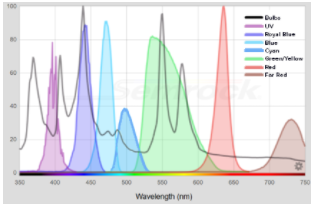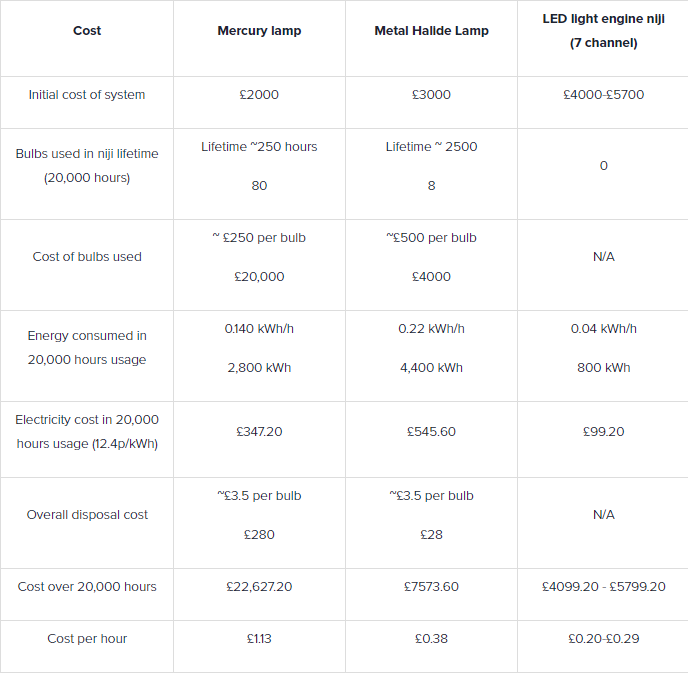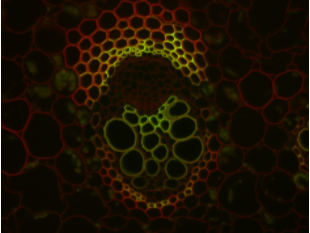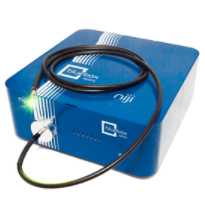This blog compares the power and lifetime value of LEDs, mercury lamps, and metal halide lamps.
This blog was written by our fluorescence microscopy specialist, Karen McGeachy.
Introduction
Traditionally the light sources used on microscopes have consisted of either Mercury or Halogen bulbs. They are powerful, cover the visible spectrum, the bulbs are relatively low cost, and at the time they were the best light sources available.
That was true until LED technology was developed and in particular over the last few decades there has been a drive to make LED Light Engines a suitable and advantageous replacement for bulbs in microscopy.
Speak to any microscope user or facility manager about bulbs and you will undoubtedly hear the groan of resentment in their voice. That is because despite their merits, bulbs are in general one of the biggest bugbears when it comes to microscope maintenance.
They have a relatively short lifetime (on the order of 300-2000 hours depending on the type), and as you get close to the end of life you then play the precarious balancing game of waiting until the last possible moment to replace the bulb in order to get as many hours as you can whilst making sure it doesn’t go bang!
Then you have to spend time aligning the new bulb whilst trying to dispose of the old one in a way that won’t be damaging to the environment. People might be thinking “That’s not so bad, it’s only a couple of hours of your time every few months, it doesn’t really effect you day-to-day”.
However, when you take into account that they need at least a half an hour to warm up before use, and half an hour to cool down, they end up staying on most of the day even if the microscope spends a few hours not in use. Couple that with a new user who accidentally forgets to turn it off before going home for the weekend then those hours really start to add up and before you know it you are having to change the bulb a lot earlier than you initially anticipated.
Another downside to bulbs is that although they do have a very broadband spectrum which encompasses the visible wavelengths, they also have a high emission in the UV and IR which can damage your cells in your sample.
Why are LED Light Engines a great alternative?
The biggest advantage of an LED light engine is that they don’t have a warm up or cool down time. Therefore, the microscope is ready and good to go as soon as your sample is ready.
If your microscope isn’t being used for an hour or so you can turn your LEDs off – saving electricity! You can also turn them off and on extremely quickly so they are only on when you need them to be.
Typical lifetimes of the LEDs are on the order of 20,000 hours, so no need to worry about replacing them every few months, or years for that matter! LED light engines are made up of a number of individual LEDs that are combined together to cover the visible spectrum.
Thus, specific wavelengths can be selected and they don’t need to include UV or IR so will not damage your cells. Obviously there is the environmental factor, you don’t need to worry about how to dispose of them as they aren’t harmful to the environment like some of the bulbs. They also have a much lower power consumption again saving on that electricity bill.
LEDs don’t have enough power for my sample, a common misconception.
Whilst it is true that some bulbs do have a higher power than the LED Light Engines in the market, a lot of the time this power isn’t really needed. For live samples in particular you don’t want to blast them with lots of power as you end up destroying them.
In fact, many users end up turning the LED power down because of this. In fixed cells and cases where you may need higher power there are a couple of changes to allow you to make the most out of the LEDs:
Make sure your filters match: this is the most common reason why people believe LEDs are low power. The bulb spectrum and LED spectrum don’t match up 100% so there can be peaks at slightly different wavelengths. If your filters are designed for bulbs then they may not match for your LED and block most of its light.
Make sure you have a good camera: not only does having a camera with a low-noise level and high QE increase your signal to noise, it also allows for lower light levels which prevents photo-bleaching and prolongs the lifetime of your sample. This allows you to achieve beautifully contrasted images.

Good sample prep: making sure that you have a well labelled and prepared sample does wonders for the efficiency and quality of your images. Meaning, you don’t need to use such a high excitation power therefore preserving your sample.
Is the cost really too high?
Taking into account the complete lifetime cost of an LED Light Engine and a bulb, you may be surprised to find that the LED Light Engine is actually significantly lower cost. This is because with bulbs you have consumables in the form of replacement bulbs and disposal, as well as the electricity costs being much higher than the LEDs.
The table below outlines the differences in costings.

The initial cost of an LED Light Engine is obviously greater than that of bulbs, and for many this is more than what the consumable budget can allow for you. So some users may be finding it difficult to get funding for the initial purchase of the system. Avenues which we have found to be successful is discussing with your Sustainability Department as they can have funding available to help the institute become greener.

How can we help you make the change to LED Light Engines? Would splitting the cost of a system over a period of a year or so help? Let us know your ideas by contacting us here:
































